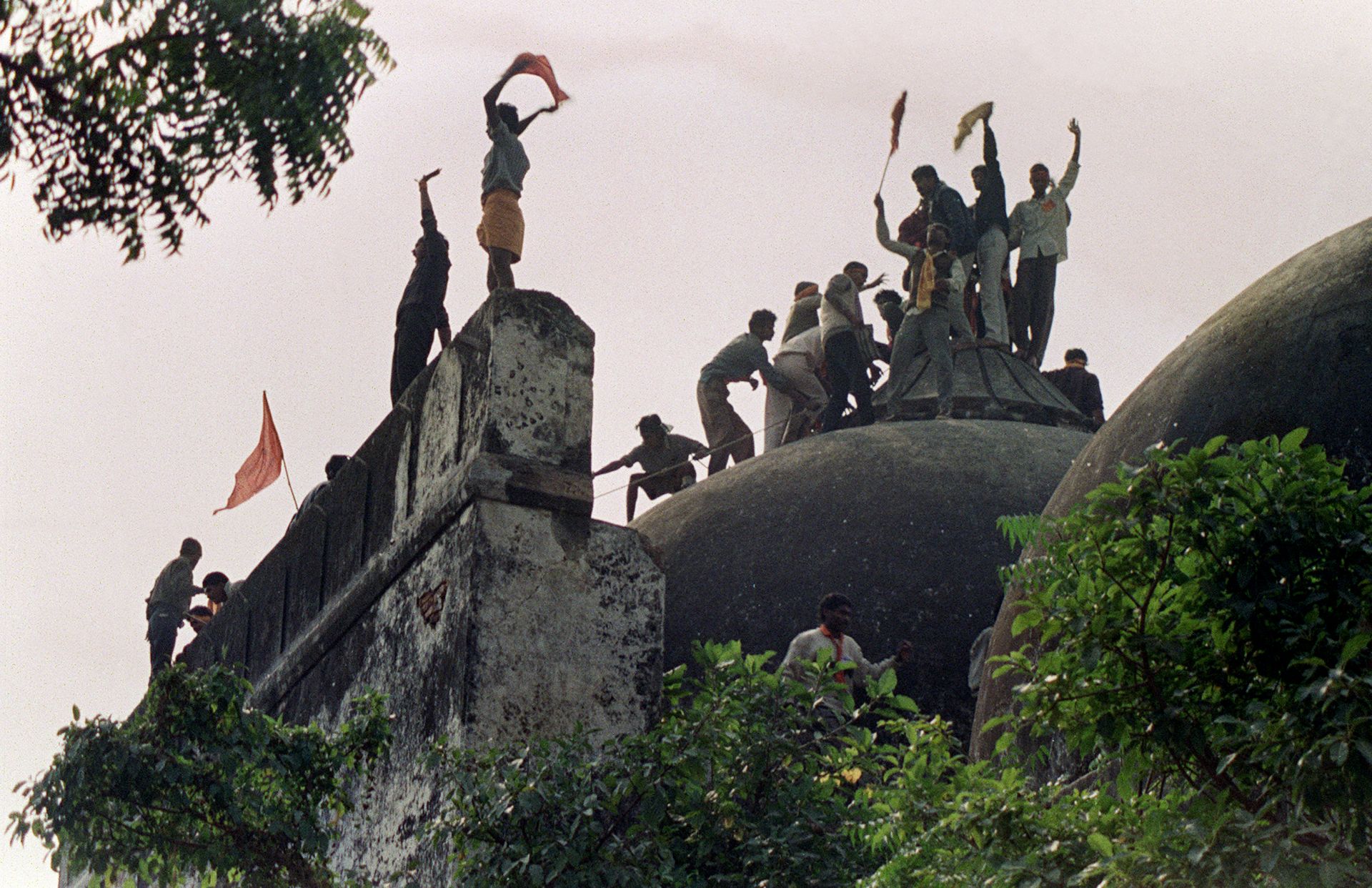On the warm winter Sunday of Dec. 6, 1992, I was sent as a reporter for a television station based in Delhi to the northeastern Indian town of Ayodhya. I had come to report on a massive political rally by Hindu nationalist groups expected to take place in the ancient town. Ayodhya, considered holy by several religious communities, has been praised for its beauty and culture since classical times. Buddhists know the town as an important religious center. Hindus respect it as Ram Janmabhoomi, or the birthplace of Lord Rama, an important and popular god in Hinduism. To Muslims, it was the site of the large and imposing 464-year-old Babri Masjid, a mosque said to have been built on the orders of Emperor Babur, the founder of the Mughal Empire.
It was that last part of Ayodhya’s rich history that would be violently erased on that day.
Hundreds of thousands of Hindu nationalist protestors had been allowed to gather in Ayodhya by the province’s sympathetic governors, headed by the main political party of the Hindu right, the Bharatiya Janata Party (BJP). Prominent leaders of the BJP, including its president L.K. Advani, future president Murli Manohar Joshi and the acting president of an associated group called the Vishva Hindu Parishad (VHP), Ashok Singhal, along with several members of parliament, gathered outside the mosque that morning and circled it ceremoniously. They would soon be escorted by their supporters to a staging area that gave a clear view of the terrible spectacle that would come next. Their actions were the starting gun for a riot that would change the face of ancient Ayodhya, as well as India itself.
Things deteriorated rapidly from about noon, as the security forces guarding the mosque disappeared, as if on cue. Local civil administrators were caught on video watching idly as swarms of rioters stormed the site armed with hammers, axes and grappling hooks. They began to carry out the task for which they had come: to demolish the mosque brick by brick. Vandals were allowed to run riot and tear the mosque down, while reporters and camerapeople in the area were beaten, attacked and prevented from recording and telling their stories. The carnage continued seemingly without end.
The paramilitaries and army personnel camped nearby were not allowed to enter the area till two days later, on the morning of Dec. 8, 1992. By then, the three large domes of the mosque had been leveled to the ground and a temporary Hindu temple was installed under a tent. Ripples from the destruction of the Babri Masjid were felt well beyond the town and province. In the weeks that followed, thousands were killed and injured in rioting across the country. The cosmopolitan city of Mumbai witnessed its worst communal violence and deaths in a century, as riots raged for an entire month. India’s image, internal security and national spirit all suffered gravely.
Next week will mark 30 years since the destruction of the Babri Masjid. Torn down by a mob in full public view, the demolition of the mosque, coming on the back of a massive public mobilization organized by the BJP, shook India’s secular foundations. For the first time since 1950, the year India became a republic, a party had openly made national politics about religious identity and introduced majoritarianism into the political mainstream. The Babri Masjid demolition was a turning point for the BJP’s political fortunes. Once confined to the margins, the party has steadily grown into an establishment juggernaut, winning absolute majorities in both of India’s most recent general elections in 2014 and 2019. Under its leader, India’s Prime Minister Narendra Modi, the party has reshaped Indian culture and politics, using its own interpretation of ancient history as a tool to ramp up polarization between Hindus and Muslims.
Much of the dominance of the Hindu right in India’s politics today can be traced back to the movement to destroy the Babri Masjid and build a temple for Lord Rama, a key Hindu deity, where it once stood. Many Hindu nationalists maintain that the mosque stood at the exact spot where Lord Rama had been born. This belief had been popular in the area for decades, starting in the late 19th century. After the 1980s, a campaign initiated by political activists gave it new vigor. The claim that the mosque marked the exact spot of Lord Rama’s birth was weaponized to foment anti-Muslim sentiment in general. The campaign was driven by organizations under the umbrella of the Rashtriya Swayamsevak Sangh (RSS), the mother organization of the Hindu right, founded in 1925. The RSS is now India’s largest paramilitary and most powerful civil society organization. Several members of the present government, including Prime Minister Modi, have been schooled by it and gone on to serve as pracharaks, or propagandists, for its ideas.
The RSS has been banned three times in independent India. The first time was in 1948, in the aftermath of the assassination of Mahatma Gandhi, the father of the nation. The assassin, Nathuram Godse, had himself been an RSS member. A new and acclaimed biography titled “Gandhi’s Assassin” by the Delhi-based journalist Dhirendra K. Jha found no evidence that Godse ever left the organization, though the RSS maintains he had quit the group before he pulled the trigger to kill Gandhi.
The destruction of the Babri Masjid injected momentum into the campaign to turn India into a country for Hindus alone. It set the stage for portraying Islam as a religion and lifestyle alien to India, ignoring the rich history of coexistence and cooperation that have long prevailed on the subcontinent. The year 1992 marked the beginning of a drastically new form politics, aided by powerful private media organizations, which depicts Islam not just as violent but as “foreign” to Indian culture.
Today, Indian Muslims are increasingly depicted as outsiders in textbooks, official documents, speeches, cinema and media debates that have saturated the public sphere. Despite well over a millennia of presence in the subcontinent, Muslims are now painted as marauding outsiders who came to India via conquests from Central Asia and the Middle East. The framing of famous Indian dynasties like the Mughals as foreign Muslim occupiers, despite the fact that all their leaders after their founder Babur were born in India, has become a staple of India’s contemporary culture wars. This distorted history ignores the complex links between rulers and people, as well as the interactions between innumerable elite and common Indians, of all religions, who contributed to keeping these indigenous empires afloat.
In 2019, a landmark ruling by the Indian Supreme Court awarded the spot where the Babri Masjid once stood to Hindu nationalist litigants, further legitimizing majoritarian rule. The open endorsement of the court’s ruling by Prime Minister Modi — who presided over prayers at the foundation stone-laying ceremony for the new temple last year, behaving as a head priest rather than the head of the government — has undermined India’s secular system and commitment to equality. India now stands at a crossroads, with the very place of its Muslim citizens within the nation now in question.
The fate of the Babri Masjid suggests communal hatred is now the defining story of Islam in India. Yet the 30th anniversary of its destruction may be an apt time to look for a different narrative. A treasured monument in the south of the country tells a different story about the advent of Islam in South Asia and the role it continues to play.
On the shore of India’s southernmost state of Kerala lies South Asia’s first mosque, a living monument to the arrival of Islam in India via traders, travelers and seafarers in the 7th century. These early Muslims took the maritime route to India and were a part of an open cultural exchange at what was then called the port of Muziris. This small but important mosque in Kodungallur (once Cranganore), known as the Cheraman Perumal Juma Masjid, lights up and shines like a jewel set over the chalk white floor. Mosques are usually understood to look a certain way — a style popularly known as Indo-Islamic, with domes, minarets and features that look distinctly Persian. However, this mosque is a typical Keralan structure with white walls, wooden doors and windows and a maroon tiled roof — a style characteristic of other local holy buildings, including temples and churches. Surrounded by a busy street up front, its backyard opens into a body of water lined with lush greenery.
A local ruler, King Perumal of the Chera dynasty, came to know about Islam through travelers and ordered the mosque to be built. Legend has it the king saw a split moon in his dreams. On discussing his dreams with traders who had come to his court from Arabia, he was told about a prophet in their land, who was preaching a faith which involved the miracle of splitting the moon, as recorded in the Quran’s “Moon” chapter (Surat al-Qamar). The conversation had a deep impact on Perumal, according to the story, and he made the journey to Arabia to meet the prophet in person. Whether the two men ever did meet in reality is unclear. What is known is Perumal fell ill on the way back and was buried in Oman. When the king’s companion Malik ibn Dinar and his followers returned to Kodungallur, the letters the monarch had written before to the local chieftains with instructions for the mosque were handed over to them. The king’s surviving companions procured permission to construct the first mosque in South Asia in 629 CE.
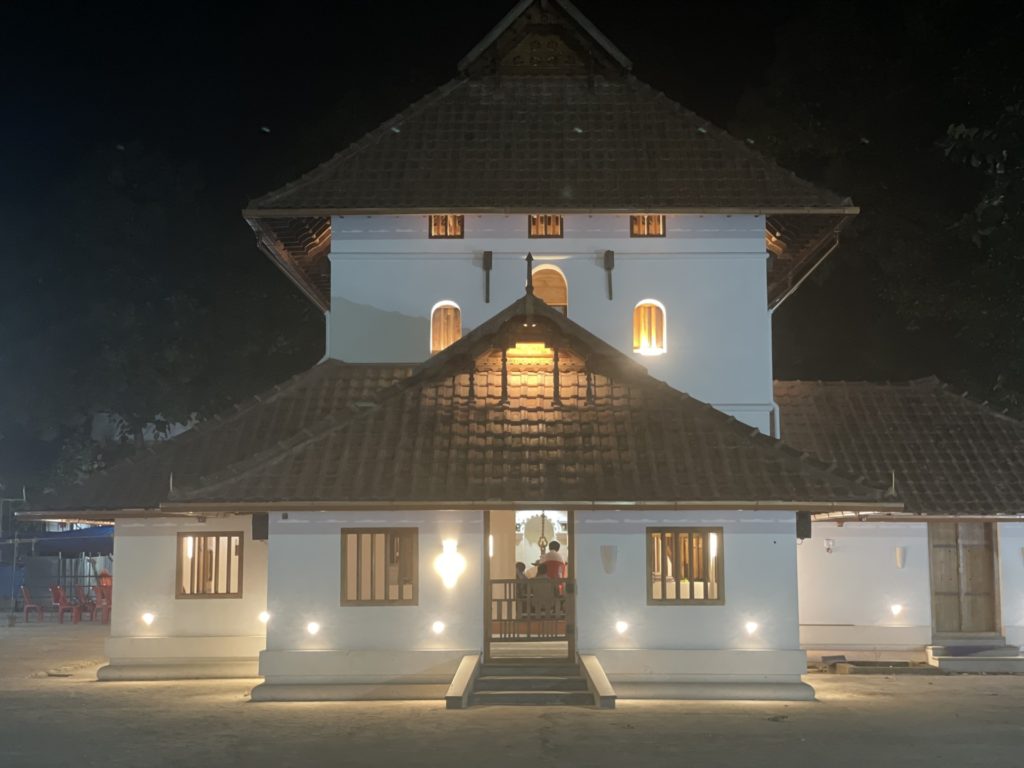
The book “Monsoon Islam: Trade and Faith on the Medieval Malabar Coast,” published by the historian Sebastian R. Prange in 2018, analyzes how oceanic trade has impacted cultural and religious life across South India historically. Between port, mosque, palace and sea, Prange concludes that “the principal agents in this extension of the medieval Muslim world were not sultans, soldiers, or scholars but ordinary, humdrum traders whose main objective was not to spread their faith but to turn a profit … this process was fundamentally shaped by the interaction of these ordinary Muslims — ordinary in the sense in that they were neither representatives of state power nor recognized religious authorities — with non-Muslim societies.”
Professor M.H. Ilias, a historian and Dean of the Faculty of Social Sciences at Mahatma Gandhi University in Kerala’s Kottayam district, is working on a detailed book about the region’s first mosque. He acknowledges that a divisive narrative of Indian history, embellished by accounts of Muslim “conquest” of Hindus, is gaining public approval and official sanction at the expense of an older story of India as a land where diverse ways of life and belief have long coexisted. He says the role of the sea in facilitating the peaceful movement of people and ideas is being neglected, despite the fact that Islam’s first encounter with the Indian peninsula happened with the Arabian Sea as its gateway. Ilias is currently working on an exhibition, “Sea – A Boiling Vessel,” focused on the sea and oceans as central to the spread of civilizations and ideas. “Artists, performers, scholars and intellectuals will contemplate together on the cosmopolitan pasts previously unheard-of and the fluid futures of maritime Kerala,” he told New Lines.
This, say historians like Ilias, was a very different influence from what armies principally brought over land from north India. Far from being about the “sword,” the contact that the sea fostered between India and the Islamic world was a story of traders, sailors and preachers who went on to give birth to a syncretic culture that survives all the way to the present — a narrative very different from the story of violent invasion now popular in northern states.
Despite its antiquity, the Cheraman Perumal Juma Masjid has not been left untouched by modern trends. Mohamed Sayeed, a medical doctor and the soft-spoken head of the mosque committee, told New Lines the mosque began to alter its appearance in the 1960s, when many Keralites left to work in West Asia. These workers were impressed with the styles of mosques seen in wealthy Gulf Arab states. Upon their return to Kerala, several minarets and structures were added to the original building. This redesign altered the appearances of the mosque in fundamental ways, which the locals eventually soured on. “Two years ago, we set about restoring it to its pristine state and took it down to its basic look — of the two-storied square structure and tiled roof — just very Kerala and very rooted here,” he said.
Benny Kuriakose, the head of a reputed group of architects and designers who specialize in restoration, worked on the mosque between 2019 and 2021. The task of pulling down the additional features added to the mosque was a delicate one. “Over the years, the Masjid underwent a lot of additions that dishonored the historic aspect but were made to expand the space of the mosque,” he told New Lines. “Renovation was done in 1994 to accommodate the increasing population of devotees, but then soon the original structure was planned to be revived owing to its history. Luckily, the core part of the old mosque is still intact.”
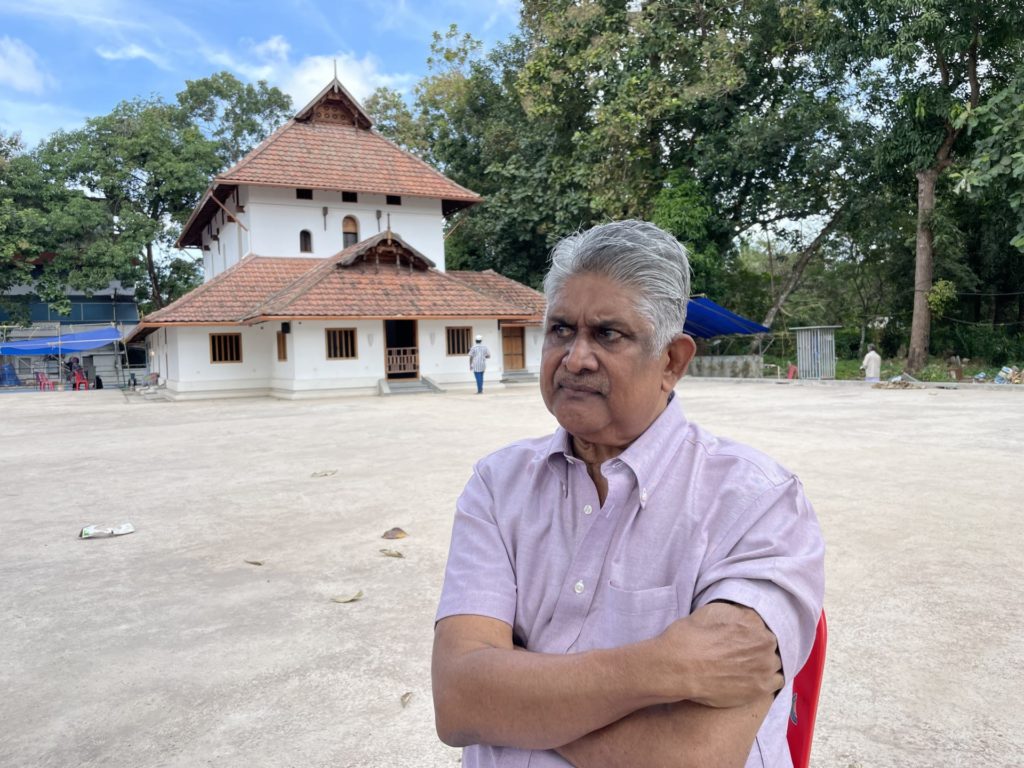
A basement is currently being built to house more worshippers, as more than 300 people cannot presently be accommodated within and outside in its courtyard. “This restoration itself is a symbol of the harmony it stands for,” says Kuriakose. “A Christian architect and Hindu carpenters have restored a Muslim mosque to its pristine old self. This is in the village of Chendamangalam where a church, mosque, temple and synagogue stand close to each other.”
Most mosques in India are found in the center of large and dense settlements of Muslims. Yet this one is surrounded by people of all faiths who live and work around a busy market square. Sitting outside in a corner of the mosque’s compound, as women are not allowed in the praying area, I noticed on a recent visit that it was especially crowded, as all mosques are, on a Friday afternoon. A steady stream of worshippers, mostly young and middle-aged men, came to perform their prayers. A bakery across the road served black tea along with local confectionery. The scene was a perfect picture of the rhythm of life in the town and the vital place of the old mosque.
Inside the mosque, an old brass lamp — commonly found in Hindu rituals — sits right in the center of where the namaz (prayer) is offered five times a day. The lighting of the lamp is an old local tradition. Members of all communities donate oil to keep it burning at all times. A mosque committee member told New Lines the lamp had been there for more than a millennium and was a symbol of the multiple traditions that make up this rich tapestry of South Asian heritage.
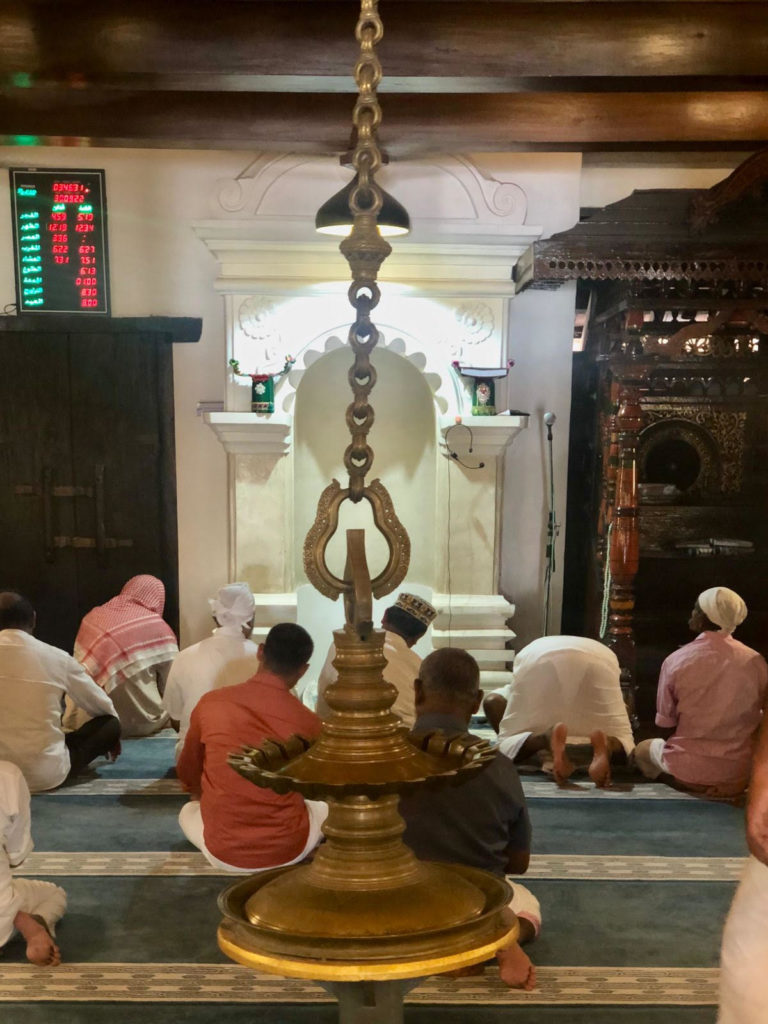
The mosque fits naturally into a broader historic landscape. Located in central Kerala, Kodungallur, known as the “Rome of the East,” was “a gateway into India and the site where one could witness the miraculous sight of the confluence of the Periyar River and the Arabian Sea,” in the poignant description of a local tourism office. Kodungallur was known as a legendary port in international maritime trade, until devastating floods in 1341 brought its golden era to an end. The full scope of its medieval importance is now being discovered anew, thanks to recent excavations that began in the region called Muziris, as it was known to the Greeks. These excavations, still ongoing, have established the region’s centrality to South Asia’s contact with the Western world via the sea, marking it as the place where the three Abrahamic faiths — Christianity, Judaism and Islam — made first contact with Indian shores.
Kerala is an outlier in India for many reasons. Foremost are its extraordinary social indicators. Historically, the state has had a strong record of social reform and voted in one of the world’s first democratically elected communist governments in 1957. Redistributive measures, land reform and generous spending on healthcare and education have earned the “Kerala model” of development high praise from leading development economists such as the Nobel laureate Amartya Sen. This is in sharp contrast to the limited economic progress and virtually nonexistent social reform in northern and western India, which have left those regions captive to the politics of identity and polarization. In terms of fertility rates, per capita incomes, literacy and women’s empowerment, Kerala has jumped light years ahead of most of the country.
Secondly, Kerala’s population is split almost evenly between Hindus, Muslims and Christians. A visible (though very small) number of Jews can also be spotted here. Kerala was kept broadly away from the horrors of Partition in 1947 that divided people in the north and took much time to heal. Post-independence politics, particularly the strong communist influence, encouraged grassroots mobilization and empowerment that contributed to making Kerala an exceptional state within India. The differences are particularly visible today, as most of the north and west of India is in the grip of the BJP’s majoritarian project, while Kerala has maintained its traditional culture of harmony.

It is impossible, except with great violence, to break India’s rich cultural mosaic into neat categories of Hindu, Muslim and British. Yet, unfortunately, the labelling of distinct “Hindu,” “Muslim” and “British” ages in Indian history — an approach pioneered by British historians in the 19th century — has undermined our understanding of India’s rich past. In his landmark book, “India in the Persianate Age,” the historian Richard Eaton explained how British rulers, Indian nationalists and Muslim separatists, each driven by different agendas, went on to use a false periodization of Indian history by faith to their advantage.
“In book after book, the tendency has been to list events, kings, battles and literary and religious texts in chronological order, each of them neatly divided into separate Hindu and Muslim compartments,” Eaton wrote. “India was thus given two Procrustean beds, one Muslim and one Hindu, into one or the other of which nearly everything had to fit — architecture, dress, art, literature, language, and so on.”
This reading of history in terms of mutually exclusive religions, wrote Eaton, has “come at enormous cost. For one thing it has made it difficult to account for, or even to see, larger cultural processes.” History should be about seeing and understanding enormous civilizational advances as the result of confluences in the fields of art, culture, science, music, language and lifestyle. Yet if the focus is only on periods where daggers were drawn between different groups, our visions of both past and future will become dangerously constricted.
Despite ongoing efforts to portray Hindu India as the only authentic India, the truth of Kerala’s first mosque is impossible to deny. The Muziris Heritage Project is also collecting histories of South Asia’s first synagogue and church, both present in Kodungallur, making it clear that India has been home to all Abrahamic faiths for centuries. The glory days of the old port of Muziris may be a memory today, but its spirit survives in the ancient mosque, church and temples that remain in daily use. One of the oldest surviving Jews in Kerala, a 79-year-old named Namia, has been living in his ancestral home all his life. Meeting New Lines at this home, he smiled as he described the cultural mosaic of his town, saying, “This is my birthplace, the only home I know and I have, so all of us living together has always been the case here. It is all natural for me.”
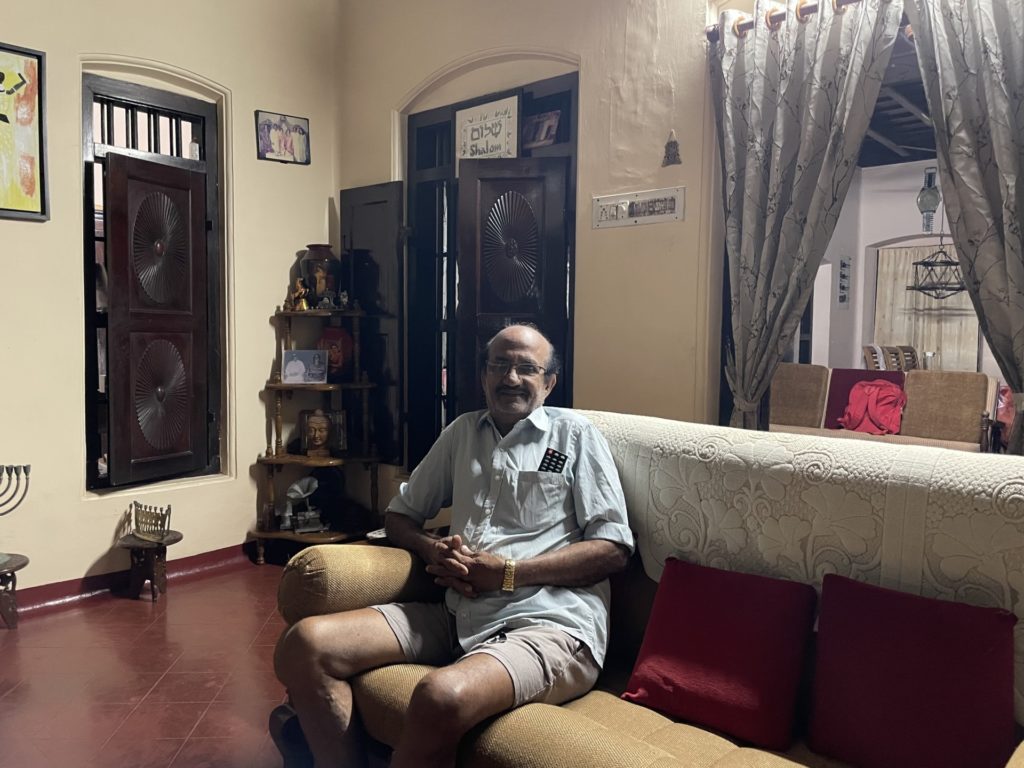
In its long history, India has seen episodes of harmonious coexistence as well bitter conflict. How Indians choose to interpret their past speaks more about them today than the reality of their ancestors’ lives. India must decide if it is a country looking for internal villains, by presenting the destruction of the Babri Masjid 30 years ago as a symbol of slavery avenged, or if it wants to look at the quiet Cheraman Juma Masjid by the Arabian Sea, which tells a very different story about Islam’s birth in the subcontinent, one of coexistence with Hinduism and other faiths, enduring now for over a millennium.



